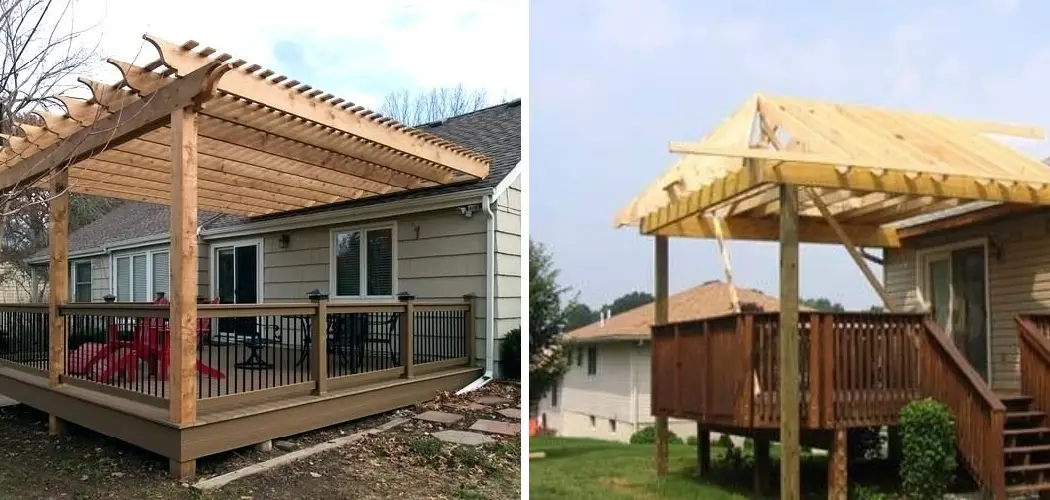If you have a deck, it’s nice to have the option to spend time there in all weather conditions. That’s where a roof over your deck comes in. A roof provides shade and keeps out rain and snow, making it easier to enjoy your outdoor space. However, it’s important to properly support the roof to ensure it’s safe and long-lasting.
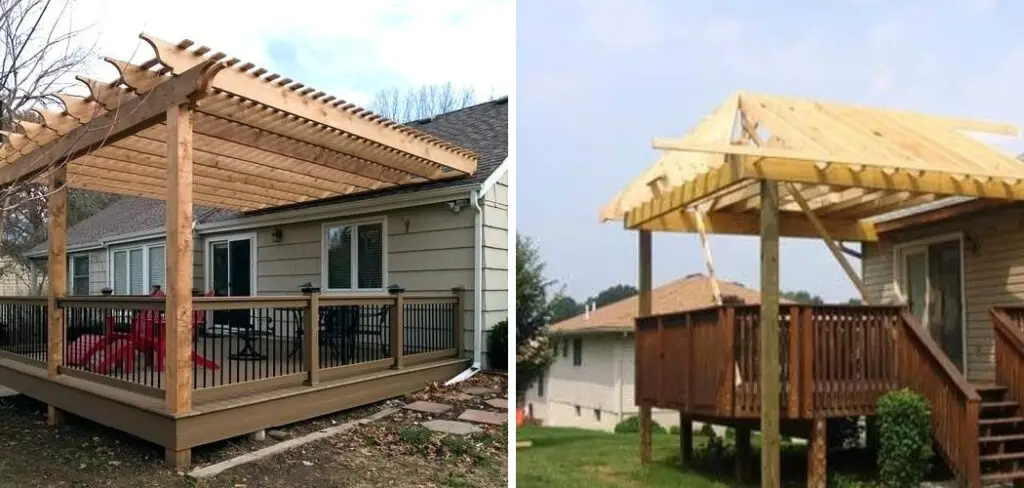
In this blog, we’ll discuss how to support a roof over a deck so that you can enjoy your outdoor living space even more.
Can You Support a Roof Over a Deck?
Creating an outdoor deck can transform any backyard into a private oasis. The thought of lounging in the sun with friends and family or enjoying a cozy evening under the stars is enough for anyone to build one.
But what about when it starts to rain?
Or is the sun just too intense to enjoy? Installing a roof over your deck may be the solution, but can your deck handle the weight? Understanding the different materials and options available is crucial to ensure that your deck remains safe and stable under the additional weight. So, can you support a roof over a deck? Let’s explore the possibilities.
Why Should You Support a Roof Over a Deck?
A roof over a deck can greatly enhance your outdoor living experience. It protects from the elements, allowing you to enjoy your deck even when the weather is less than ideal. Rain or shine, you can still host barbecues, relax outside with a book, or even set up an outdoor living room. Not only does a roof over a deck offer functional benefits, but it can also add aesthetic appeal to your home.
With various styles and materials available, you can customize the look of your deck and create a unique outdoor space. Overall, a roof over a deck is a worthwhile investment for any homeowner looking to increase the use and enjoyment of their deck.
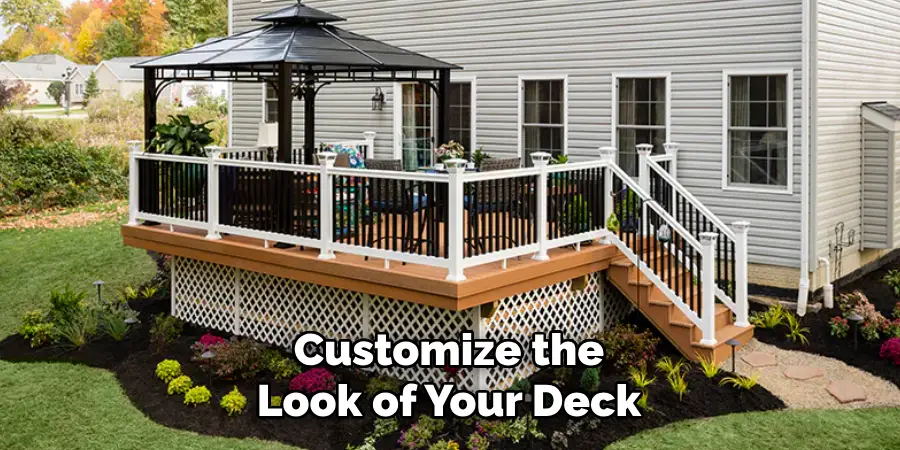
How to Support a Roof Over a Deck: A Beginner’s Guide
1. Consider the Size of The Deck
The first thing you need to consider when adding a roof over your deck is the size of the deck and the weight of the roof. The deck needs to be able to support the weight of the roof, so it’s important to have a structural engineer evaluate the deck’s capacity to make sure it can handle the additional load. The engineer will also advise you on the type of support needed for the roof, which will depend on the size and weight of the roof.
2. Decide the Type of Roof
Next, you’ll need to decide on the type of roof you want to install. There are several options, including a flat roof, a gable roof, and a shed roof. Each type of roof has its own installation requirements and load-bearing needs. A flat roof might be easier to install, but it requires a sturdy support system to avoid pooling water. A gable roof provides more headspace and a classic look, but it needs more support for the peak. A shed roof is ideal for areas with heavy rain or snow, but it needs a slope to avoid water pooling.
3. Choose the Support System
Once you’ve decided on the type of roof, the next step is to choose the support system. The support system for a roof over a deck generally includes posts, beams, and footings.
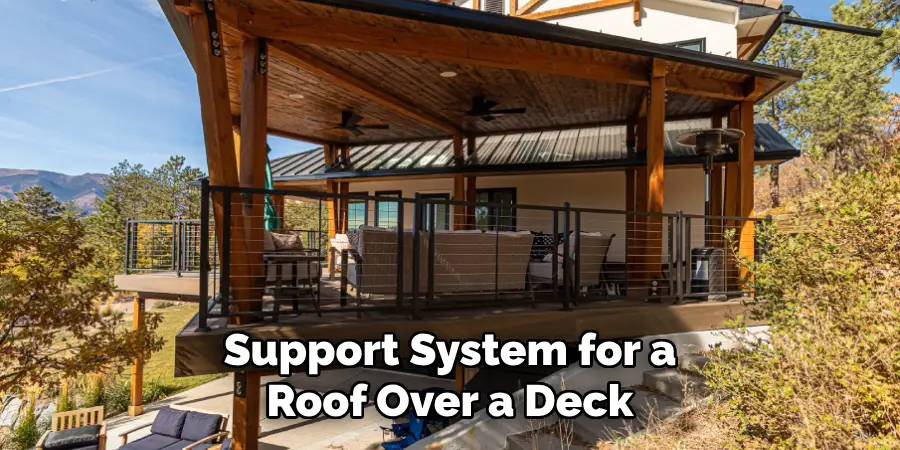
The posts are tall vertical supports that transfer the roof’s weight to the ground. Beams span across the posts and support the roof structure. Footings provide a solid base for the posts to rest on. The size and spacing of the posts and beams depend on the size and weight of the roof.
4. Install the Roofing Material
After you’ve installed the support system, it’s time to install the roofing material. There are various roofing options, including metal, shingles, and polycarbonate panels. The type of material you choose will depend on your preferences, budget, and the climate in your area. Metal roofing is durable and long-lasting, but it can be noisy during rain or hail.
Shingles provide a classic look but require regular maintenance. Polycarbonate panels are lightweight and easy to install, but they may not withstand heavy snow loads.Consider these factors when choosing the roofing material for your deck.
5. Be Mindful of Connections
When adding a roof over an existing deck, it’s crucial to pay extra attention to connections between new and existing structures. The connection points should be strong and secure to withstand the roof’s weight. It’s best to consult with a professional contractor or engineer to ensure that the connections are properly installed.
6. Include Drainage
Proper drainage is essential for a roof over a deck to prevent water pooling and potential damage. Depending on the type of roof, you may need to install gutters or create a slope in the roof to allow water to flow away from the deck. Improper drainage can lead to structural issues and cause water damage to the deck, so it’s essential to plan for drainage during the installation process.
7. Don’t Forget about Permits
Before starting any construction project, you must check with your local building department and obtain any necessary permits. Depending on the size and type of roof, you may need a permit for safety an code compliance purposes. It’s always better to be safe than sorry, so don’t skip this step.
Remember to follow these tips when adding a roof over your deck to ensure a strong and stable structure that will enhance your outdoor living space.
By considering the size of your deck, choosing the right type of roof and support system, installing proper drainage, and obtaining necessary permits, you can create a beautiful and functional outdoor space that will last for years. So, take your time, plan carefully, and consult with professionals if needed. With the proper support system and roofing material in place, you’ll be able to enjoy your roof over your deck for many seasons to come.
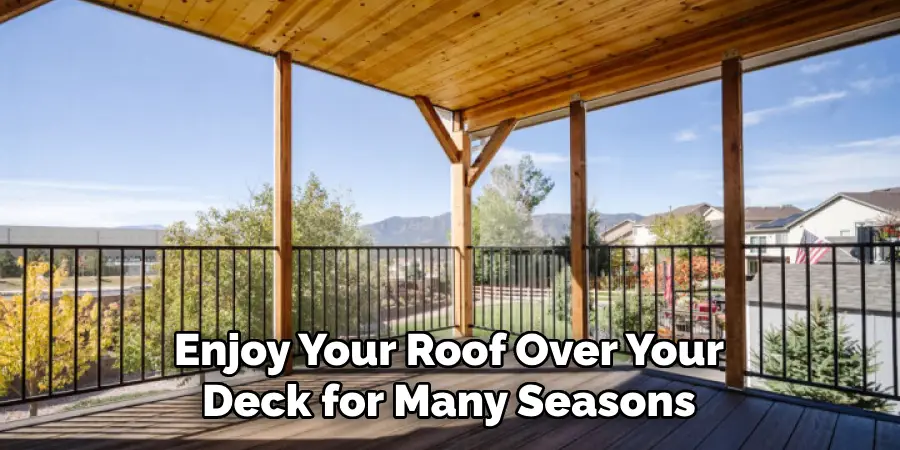
5 Benefits of Supporting a Roof Over a Deck
1. Increased Protection from the Elements
A roof over a deck provides extra protection from the elements, such as rain, snow, and sunlight. This can help to keep your deck in better condition and extend its lifespan. Additionally, a roof can provide shade and shelter on hot summer days, making it more comfortable to spend time outdoors.
2. Improved Aesthetics
Adding a roof to your deck can give it an updated look that will make it stand out in your backyard or patio area. You can choose from a variety of materials, such as wood, metal, or composite materials, which will allow you to customize the look of your deck according to your own tastes.
3. Reduced Maintenance Costs
Having a roof over your deck will help to reduce the amount of maintenance you need to do in order to keep it looking its best. Without a roof, you would need to regularly clean and seal the wood on your deck in order to protect it from the elements. With a roof over your deck, however, you won’t need to worry about this as much since the roof will provide extra protection for the wood beneath it.
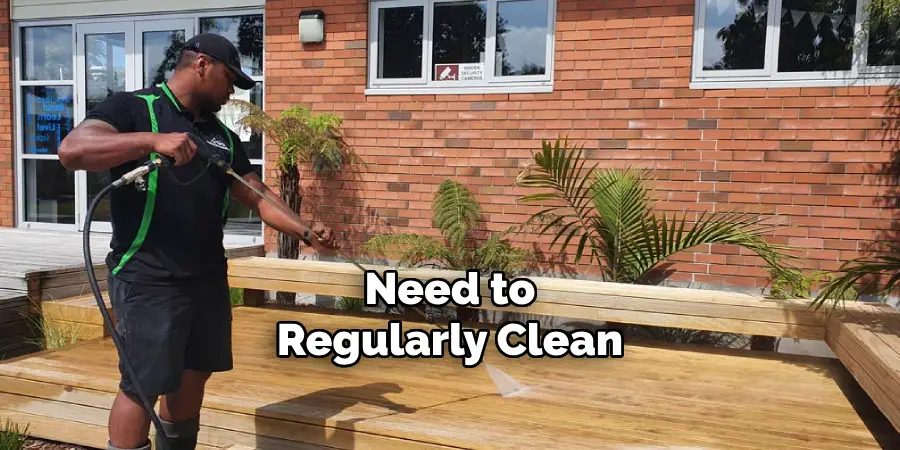
4. Added Privacy
If you have neighbors who live close by or if you don’t want people walking by to see what’s on your deck, then having a roof over it can provide some added privacy. This is especially true if you choose one with opaque panels or one that has built-in lattice work for extra privacy screening.
5. More Usable Space
Finally, having a roof over your deck gives you more usable space since you don’t have to worry about getting wet when it rains or being too hot when it’s sunny outside. This means that you can enjoy spending time outdoors without having to worry about weather conditions impacting how comfortable you are while doing so!
Some Common Mistakes People Make When Trying to Support a Roof Over a Deck
Building a roof over your deck can be a challenging and rewarding project, but it’s important to do it right. Many homeowners make common mistakes that can compromise the safety and durability of their deck roof. One of the most common mistakes people make is using inadequate materials to support the roof. This can result in collapse and damage to your home and property. Another mistake is not properly securing the roof to the deck, which can lead to leaks and water damage.
It’s also important to ensure that your roof is designed to withstand the local weather conditions, including wind and snow loads. By being aware of these common mistakes, you can ensure that your deck roof is safe and long-lasting.
Conclusion
Adding a roof over your deck is a great way to improve your outdoor living space, but it’s important to support the roof properly to avoid structural problems and potential safety hazards. Before starting any work, consult with a structural engineer to evaluate the capacity of your deck and advise on the type of support needed. Choose the right type of roof, support system, and roofing material to ensure a safe and long-lasting structure.
Remember to also install gutters to channel away rainwater and protect your foundation. With these steps, you’ll be on your way to enjoying your outdoor living space in all weather conditions. Thanks for reading our post about how to support a roof over a deck.
About
Outdoor Fixes is a distinguished figure in the world of Diy design, with a decade of expertise creating innovative and sustainable Diy solutions.
His professional focus lies in merging traditional craftsmanship with modern manufacturing techniques,
fostering designs that are both practical and environmentally conscious. As the author of diy,
outdoorfixes delves into the art and science of outdoorfixes-making, inspiring artisans and industry professionals alike.
Education RMIT University
(Melbourne, Australia) Associate Degree in Design (Outdoor Fixes) Focus on sustainable design, industry-driven projects,
and practical craftsmanship. Gained hands-on experience with traditional and digital manufacturing tools, such as CAD and CNC software.
Nottingham Trent University
(United Kingdom) Bachelor’s in outdoorfixes.com and Product Design (Honors) Specialized in product design with a focus on blending creativity with production
techniques. Participated in industry projects, working with companies like John Lewis and Vitsoe to gain real-world insights.
Publications and Impact
In diy, Outdoor Fixes his insights on indoor design processes, materials, and strategies for efficient production.
His writing bridges the gap between artisan knowledge and modern industry needs, making it a must-read for both budding designers and seasoned professionals.

